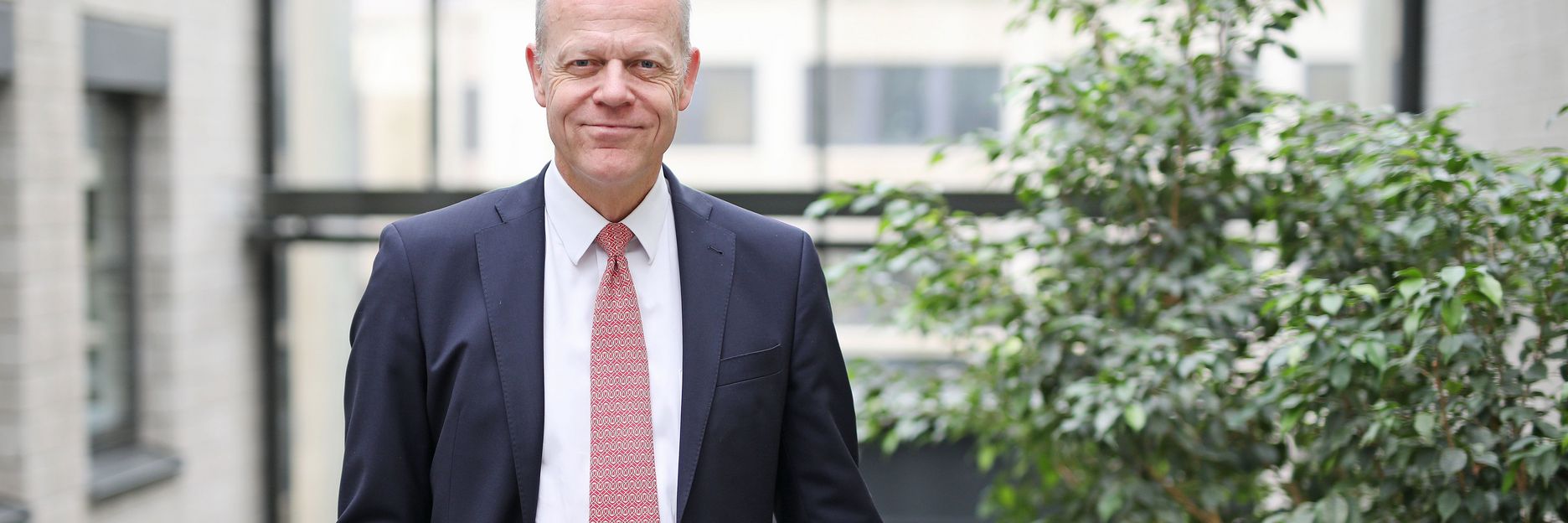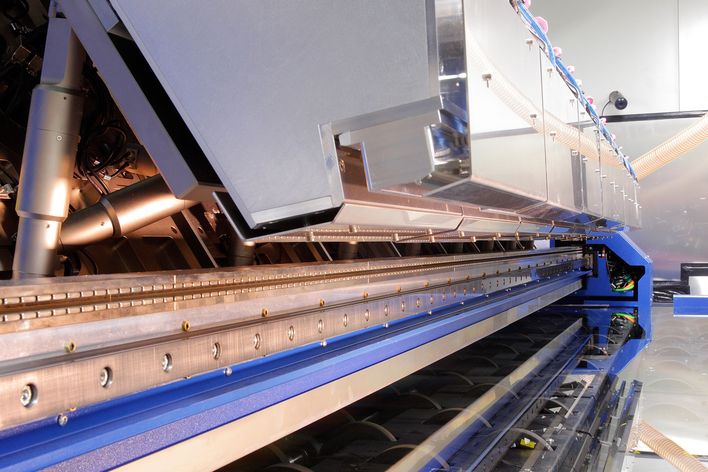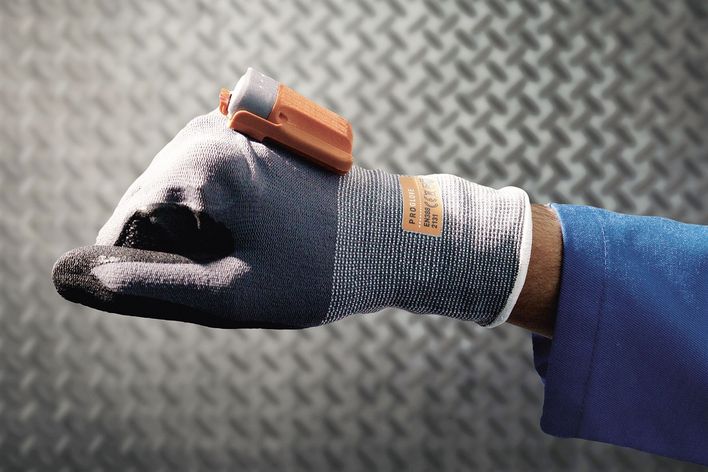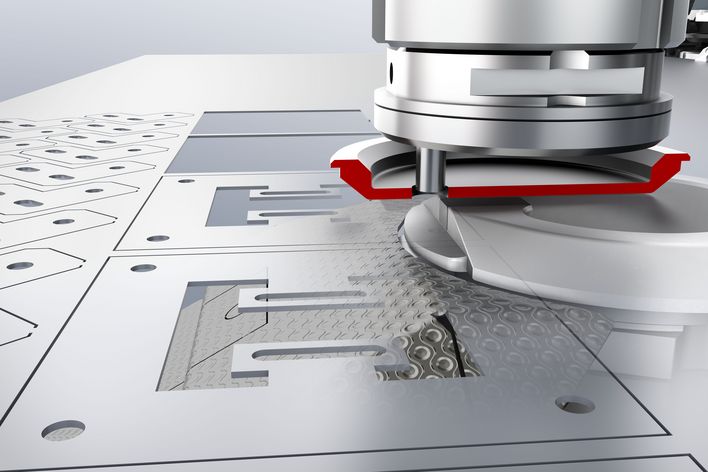Mr. Poprawe, what prompted you to become a physicist?
I come from a family of bankers, but it became clear to me fairly early on that earning a living by playing the money markets was not for me. It didn’t leave enough room for personal creativity. Making and creating – that’s what I enjoyed even as a child. I experimented on loudspeakers to the point of destruction because I wanted to improve their fidelity. And I hot-rodded soapbox racers to get them to fly downhill even faster. And then, of course, I had my Märklin train set. Wading in and wanting to know how things worked – that’s how it’s always been for me.
Can you trace this back to a particular seminal experience?
When I was 12 or 13, I had a globe in my bedroom. I’d learned a little about cartography and knew that all land masses and oceans on our planet had been surveyed and named. But what about the universe beyond that? I used to look up into the night sky and wonder: “what else is out there?” Nobody could give me an answer, but I wanted to know all the same.
Is this why you see yourself as a researcher?
Without a doubt. But that’s just one part of me. I’m five people in one, and each part makes me who I am.
So, what are these five sides of your personality?
The first is someone who wants to know everything. And if no-one can provide the answers, that guy is going to go looking for them himself. That’s what I’d describe as the researcher in me. The second aspect of my personality is the family man who wants to do the best he can for the sake of his family – for my wife, my children, and their children, and so on. But I’m also a typical male, an assertive guy like Zorbas the Greek. That’s when I say: “Get out of my way! I’m going that way no matter what you think.” This man is stubborn as a bull – that analogy appeals to me because it implies virility and persistence. But I’m only like that 20 percent of the time.
That leaves two more sides...
The fourth is a man in search of harmony and beauty; a seeker, a poet, an artist, if you will. I like to paint and write poetry, especially sonnets. I have a strong affinity for these modes of expression. The fifth and last part of me is the philosopher. Hegel’s thoughts shaped who I am, the idea that apparent opposites are reconciled in a synthesis. But the philosopher who probably influenced me most is Immanuel Kant: "Nothing can possibly be conceived in the world, or even out of it, which can be called good without qualification, except a good will.” I share Kant’s belief in a categorical imperative, an inner law of reason and true morality rooted in human nature itself.
That certainly was a quick but thorough introduction. Do these five personas play a role in your work at the institute?
To the extent that I’m aware of their presence, yes. I believe the entirety of a person is a big factor in their personal growth. The same goes for my team and for processes. We work together in interdisciplinary teams, and I always expect my people to be aware of their inclinations while at the same time recognizing the strengths of those versed in other disciplines. It’s all about creating a healthy balance and accepting diversity. It’s very important to me that all disciplines should be treated with equal respect. Within the four walls of the institute, it’s the very essence of our dealings with one another. We promote a culture of openness.
In what way does this openness manifest itself?
For instance, by being open to new ideas. This is tremendously important because ideas are the seed corn from which great things such as innovations are born. The ILT owes its success to the thousands of ideas proposed by its employees. Many of them are the result of trial and error – an approach that we expressly encourage. Some of these ideas we bring to life.
How do ideas come alive?
In the beginning, it’s difficult to tell whether an idea will turn out to be viable or not. Sometimes an idea will be consigned to the bottom drawer only to make a comeback later. That’s why it’s so important to keep reassessing ideas. Stay open-minded rather than narrowing your focus too soon. I’m an ascetic thinker who prefers to focus on the bare essentials. But that’s not the way to go when brainstorming ideas – do that later, when the process is underway. An idea should always culminate in an outcome. Over the past 30 years, ILT researchers have founded more than 40 spin-off companies. And, with only a couple of exceptions, they’re still going strong. When people asked me if we can turn this or that into a product, I would inevitably reply, “It’s always startup time – so set up a company and find out.” If people can see the benefit in something, they’ll be willing to pay for it.
You are known as the father of 3D printing...
There is more to it than that. 3D printing existed in 1996 when I joined the institute. But they were primitive machines, more compatible with plastics than metal sintering. The properties of the materials were nowhere near what ought to have been possible. To be honest, I wasn’t a great fan of plastics, probably because I’d spent ten years working for Thyssen. I wanted to print purely with metals. We had what we needed at the institute, and so that’s what we set out to do.
Our first goal was to achieve a density of one. That took five years. And even then, the world was still painfully unaware of what could be achieved with 3D printing. We didn’t even have a single documentable, practicable idea for an application.
It took us ten more years to print components with tensile and bending strength comparable to that of conventionally manufactured parts. Then people started taking us seriously. Now, twenty years later, we can sinter metal like a foundry. With 100-percent density. But on a scale of 1:1,000 cubic micrometers. The ILT owns patents for the complete melting of metal powder, and here I have the world’s first 3D-printed production metal component for the automotive industry. It was a real milestone that BMW achieved with us. This is a folding hinge for the soft top of the BMW i8 convertible roadster. It’s a visible part.
What is the advantage of this manufacturing method?
You can make up to 100,000 of these parts a year at lower cost than with other methods such as injection molding. We call this mass customization. The first part costs no more to produce than the thousandth, regardless of quantity. That’s typical of all laser-based processes.
Another big advantage is that we work with powder rather than semi-finished parts. As a result, the development time for these products is getting shorter and shorter. We’re not in the least worried about the demand for shrinking development cycles, because we’re a hundred times faster today than we were yesterday.
Faster perhaps, but doesn’t that detract from product quality?
Quite the contrary: Take, for example, the design process. Complexity is not a cost factor. It doesn’t matter how complex the part may be, because it is printed layer by layer. And we can go straight from the design to the product at the press of a button. That’s the whole point of 3D printing or digital photonic production. And it all fits in with the wider context of industry 4.0. We don’t need any special tools to create customized products. This enables us to respond immediately to customers’ specific requests or feedback.
In what applications can this be particularly useful?
One niche area that comes to mind is medical engineering. It might take a while to get there, but we are already researching ways of printing artificial arteries, organs, or skin, and ceramics for cranial and maxillofacial implants. All of which can be tailored to the patient. Imagine how much simpler spinal surgery could be in the future: CT data would be sent directly to a 3D printer to produce a perfectly fitting implant. It would only take a small step from here to a closed data chain in which personalized surgery and medical devices become reality.
The ILT has grown substantially under your leadership. Was this growth an important part of your agenda?
Not initially; my first concern was to get our priorities right. The institute’s name in English is Fraunhofer Institute for Laser Technology ILT. To be more exact, it ought to be called Fraunhofer Institute for Laser Engineering, but this subtle distinction was lost in translation. Strictly speaking, technology is about how scientific knowledge is applied, whereas engineering is more concerned with making things work. It’s a fine point, but it’s the backbone of what we do.
From day one, our objective has been to create knowledge for the future, using all of our vast potential. The demand and market for our services has grown, so it’s only natural that we have grown too. Our workforce has increased from 250 in 1996 to no less than 800 today.
What matters to you in your role as director?
To me, leadership is about striking the right balance between challenging and encouraging people. If I’m in charge, I first need to earn the trust of the people I’m leading. Then I have to pinpoint and promote their strengths. This means I have to get together with each person to figure things out. What are your strengths, how do we put them into action, and why bother with all this? You have to define a vision and an objective.
Above all else, leadership is about respecting employees as fellow human beings. Something is surely wrong if a leader with a hierarchical mindset categorizes some people as important and others as less important.
You not only head up the institute; you also teach. What do you want to convey to your students?
I want my students to make their own decisions about the values they cherish and how they aim to grow. I want them to get a good picture of themselves and decide what fits that picture and what doesn’t. The contemporary Swiss philosopher Peter Bieri (alias Pascal Mercier) wrote an essay about what constitutes an educated person, but the features he names are more to do with personal development than academic learning or practical training. This is the kind of educated person I want my students to become. In my lectures, I try to break the subject matter down to the level of opportunities for personal growth and in this way give pause for thought. This motivates students to listen more attentively. I occasionally ask them to compile a work/life balance sheet. Or to create a mind map of the factors affecting the achievement of their objectives, for instance obtaining an academic degree.
Do your students appreciate this teaching method?
That’s for my students to say, for their opinions are very important to me. That’s also why I ask my students to assess my performance as a teacher. I’m not alone in that respect; in fact, it’s mandatory for all faculty members at RWTH University Aachen. I almost always get the same feedback: They want to see a repeat performance of the little dance I do to explain how CO2 lasers work. It goes like this:
and is meant to illustrate how carbon and oxygen molecules vibrate. The most challenging part of the choreography is mimicking stretching and scissoring vibrations. But more seriously: My department has won three teaching awards from the Faculty of Mechanical Engineering, so we must be doing something right.
What future lies ahead for the laser?
Look at it like this: There is no other form of energy in our universe that can match laser photons for transmission quality. This is because they have zero entropy. Laser light travels at the fastest velocity we can conceive of today, the speed of light. It is flexible and can be converted into other forms of energy with maximum efficiency because it behaves in accordance with the fundamental laws of physics. This is why we’re going to see a lot more photonics in this world.
How do you expect photonics to evolve?
That’s like asking someone in the 18th century what future they predict for electricity. It’s a question that nobody can answer. We’re at the same point with lasers as Luigi Galvani was at the end of the 18th century when he discovered the phenomenon of bioelectricity – and only happened to notice because a frog’s legs twitched. Other inventors were hard on his heels, and soon demonstrated the first flickers of an incandescent light bulb.
What do you think will be the next big issue in photonics?
Definitely quantum technology – that is, research into the perhaps most important properties of Fourier-limited photons that have yet to be tapped. Silicon photonics is up there too – that is, optics on a chip. We’re exploring this on very a modest scale in our integrated, interdisciplinary institute, or I3 as we call it. We hope to bring something new and trigger ideas in other disciplines by porting our laser expertise to new applications.
What is Germany’s role in the international laser community, today and in the foreseeable future?
We are a nation of passionate engineers, as Germany’s track record in the machine-building industry goes to show. Our expertise in precision engineering was a godsend to the first generation of laser specialists. Manufacturing processes have since evolved, and we now have semiconductor systems and diode lasers. We’re pretty good at that too these days. The microelectronics industry in Germany has grown into a globally competitive force, and in some cases even leads the global market.
Is this situation here to stay?
Nothing ever stays the same. The world is in constant flux. It’s hard to say where developments are heading, but it is my sincere hope that the ILT will be up front as a major actor in the future of laser technology. This will depend on our ability to muster our forces within the Fraunhofer organization and drive on with the innovation process. Then there will always be new applications for which we can deliver world-class innovative solutions.
Globalization has taken hold of the value chain to the extent that no one country can be named as the source of an innovation. An example is fax machines, which were invented in Germany but made their first commercial breakthrough in Japan. But since when was it so important to know where an invention came from? It wasn’t German scientists who invented the laser. But its American inventors are probably still kicking themselves for not having recognized its commercial potential. The simple fact is that it fitted in better with Germany’s existing culture of precision engineering. That’s why the spark passed, and the rest is history. So, keep your eyes open for the next passing spark. We are always open to changes that can lead us to a better future.
What vision lies behind the I3 concept?
I3, or the integrated, interdisciplinary institute, is based on a research vision shared by different faculties. The idea is to develop new priorities and fields for research. For example, we have electrical engineers and business managers working together on the same project. Both have to think beyond the box. What’s going on outside my own discipline? How can I be more useful to the organization as a whole? With I3, we have created a space that bridges communication gaps in a very efficient way. Little things like a shared cafeteria can be hugely productive. It provides an informal meeting space where people can connect and talk face-to-face.
You built a strong network. What’s going to happen to it when you retire?
Each node in a network represents a person who in turn is connected to other people by bilateral bonds of trust. These bonds of trust are a useful means of expediting decision-making processes. Examples include recommending candidates for promotion to a new post or selecting suggestions for process improvements.
I have always encouraged my coworkers at ILT to network, in both the physical and figurative sense. So, they’ll still be well connected even without me around. And a good successor will continue in that vein.
What are your sentiments on the eve of your retirement?
I’m leaving in good spirits. I’m confident that I can safely hand over the reins to someone else. If I insisted that my principles as director of the institute were to be engraved in stone, I’d be depriving my successor of the possibility to go one better. As Leonardo da Vinci once said: “Poor is the pupil who does not surpass his master.” Otherwise, there can be no progress.
And what will you leave behind?
Any lasting trace of my work will depend on what comes next. My successor will have ideas of his own. But I do hope that the culture of flexibility and openness I have built will remain alive. It would be nice if the employees would continue working in this spirit.
How do you intend to keep busy as a pensioner?
Since my daily activities will be different, the ratio between the five sides of my personality will change accordingly. I am sure that the artist and the philosopher will come to the forefront. Then I’ll finally get around to filling in the gaps in my modest knowledge. Some good friends of mine went back to school. I could do that too and study philosophy, for example.
May we ask a couple of personal questions in closing?
By all means.
Which three books should everyone read sometime?
Paul Watzlawick: The Situation Is Hopeless But Not Serious (The Pursuit of Unhappiness)
Umberto Ecco: The Name of the Rose
Johann Wolfgang von Goethe: Faust
Old masters or contemporary art?
Old masters back in the day; now it’s contemporary art.
Do you believe in God?
No, I don’t believe in God. But I’ve been told that that has nothing to do with whether God exists.
There are many things between heaven and earth that our limited senses are unable to comprehend. We can only see a small slice of it, but we are part of something much bigger – of that I’m certain. And if people feel the need to personify that “something bigger”, then that’s God.
What about theater? Do you have a favorite play?
Faust, of course. And Shakespeare’s Midsummer Night’s Dream and King Lear. (he recites in a thunderous voice) “Nothing will come of nothing!”
Impressive! Do you perform on stage yourself?
Every day. (he grins)
Professor Reinhart Poprawe was born in 1954. He has directed the Fraunhofer Institute for Laser Technology ILT for 23 years and is a co-initiator of RWTH Aachen Campus, where he heads the Photonics Cluster. During this time, the institute and its associated academic chairs have grown into a significant hub of laser research in Germany. Poprawe himself has never ceased to learn, winning numerous prizes, receiving many honorary distinctions, and gathering widespread recognition along the way. He will be taking his retirement in 2019. His legacy is a well-run institute primed for the future and a culture of openness.





